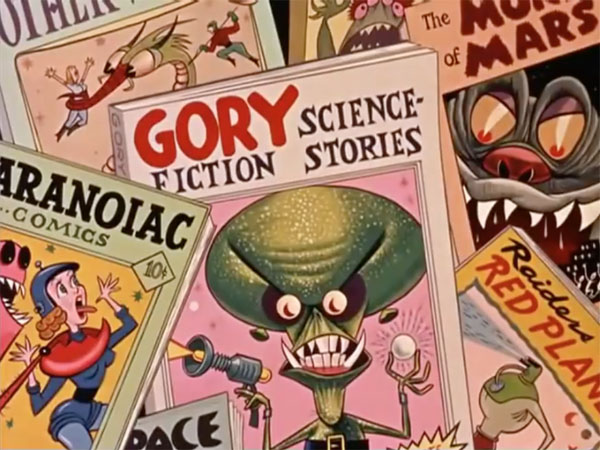
The 1950’s were upon us. Alien presences were creeping more and more into standard pop-culture consciousness. George Pal’s fantasy films (mentioned in last week’s article) had opened the realm of space science fiction to a mass media attraction. Other producers were beginning to follow suit, such as at the monster house at Universal, where a creative and ingenious 3D-thriller, It Came From Outer Space used the unique touch of leaving the horrendous details of the invading alien to our own vivid imaginations – instead presenting the alien only in first-person POV shots, as seen through the warped vision of an alien gelatinous eye. Other studios (such as American-International, or the low-budget B-pictures of Sam Katzman at Columbia) would attempt to cash in on the fad (and in fact do so) with stretches of the imagination of such low technical quality as to defy anything that had ever graced (or disgraced) the silver screen – as, for example, Katzman’s The Giant Claw presenting a giant alien “buzzard” that somehow eludes all radar detection and is partially composed of antimatter. (In actuality, it looks like it is composed of remnants of a sock puppet and portions of the leftovers from a Thanksgiving dinner!)
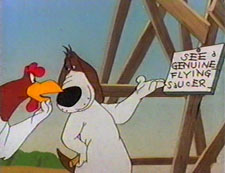 Sock-a-Doodle Do (Warner, Foghorn Leghorn, 5/10/52 – Robert McKimson, dir.), actually falling within the chronology of cartoons reviewed last week, provides a throwaway gag exhibiting the effects of the new space craze upon public consciousness. Activity opens at the barnyard with the Dawg constructing a device from a long section of pipe on an angled elevated scaffolding to resemble a telescope, on which he hangs a sign, reading, “See a genuine flying saucer”. “I don’t believe it”, Foghorn blusters, “but I’ll take a look anyway.” Foghorn accuses the device of being no good – just “a lot of air with a hole around it.” At the other end, Dawg has fastened a large rubber band, which he has stretched to a nearby tree, where he inserts a large plate into the band to fire like a slingshot. “Keep looking”, instructs the Dawg, as he releases the plate. Foghorn excitedly announces that he can see it as plain as day, and that we’re all “goners” – but gets smacked in the head by the plate which shatters with a loud crack. Dawg follows it with a teacup that hooks its handle around the tip of Foghorn’s beak, then appears with a sugar bowl and asks Foggy, “One or two lumps, sir?” “Two, please”, replies a groggy Foghorn. Dawg produces the obligatory mallet, and gives Foggy his “two lumps” – on the head.
Sock-a-Doodle Do (Warner, Foghorn Leghorn, 5/10/52 – Robert McKimson, dir.), actually falling within the chronology of cartoons reviewed last week, provides a throwaway gag exhibiting the effects of the new space craze upon public consciousness. Activity opens at the barnyard with the Dawg constructing a device from a long section of pipe on an angled elevated scaffolding to resemble a telescope, on which he hangs a sign, reading, “See a genuine flying saucer”. “I don’t believe it”, Foghorn blusters, “but I’ll take a look anyway.” Foghorn accuses the device of being no good – just “a lot of air with a hole around it.” At the other end, Dawg has fastened a large rubber band, which he has stretched to a nearby tree, where he inserts a large plate into the band to fire like a slingshot. “Keep looking”, instructs the Dawg, as he releases the plate. Foghorn excitedly announces that he can see it as plain as day, and that we’re all “goners” – but gets smacked in the head by the plate which shatters with a loud crack. Dawg follows it with a teacup that hooks its handle around the tip of Foghorn’s beak, then appears with a sugar bowl and asks Foggy, “One or two lumps, sir?” “Two, please”, replies a groggy Foghorn. Dawg produces the obligatory mallet, and gives Foggy his “two lumps” – on the head.
Paramount presents several notable entries in the animation world’s efforts to keep up with this trend, and might fairly be accused of getting a bit “space happy”. In following up on the 1953 fad of the 3D movie, the studio contributes not one, but two “Stereotoons”, both with outer-space themes. The first has been discussed previously in these columns – Popeye, the Ace of Space (Paramount/Famous, Popeye, 10/2/53 – Seymour Knietel, dir.), reviewed in my post, The Invisible Article (Part 2), a 3D reworking of the earlier Rocket to Mars, with Popeye the victim of abduction by a flying saucer.
 While not quite fitting the theme of this article (as it is Casper, not an alien, who does the planet-hopping), Casper’s Stereotoon, Boo Moon (1/1/54, co-directors: Seymour Kneitel/I. Sparber), has Casper becoming a modern-day Gulliver, visiting the Lilliputian-size moon kingdom of King Luna – a dead-ringer for Bombo from Gulliver’s Travels (1939) – demonstrating again how Paramount was jumping feet first into the space age. (One final note regarding the Casper – while some posts on the net attempt to boast “recreated titles” or a “3D version”, they are all terrible fakes. The genuine 3d version, projected years ago at the Egyptian theater in Hollywood, presented the unique variation upon the traditional opening of Casper materializing in a circle, of having two Casper “spirits” materializing, one in each eye view on opposite sides of the screen, and converging into the center circle to form the three-dimensional single Casper we all know. It was quite a surprise to my eyes!
While not quite fitting the theme of this article (as it is Casper, not an alien, who does the planet-hopping), Casper’s Stereotoon, Boo Moon (1/1/54, co-directors: Seymour Kneitel/I. Sparber), has Casper becoming a modern-day Gulliver, visiting the Lilliputian-size moon kingdom of King Luna – a dead-ringer for Bombo from Gulliver’s Travels (1939) – demonstrating again how Paramount was jumping feet first into the space age. (One final note regarding the Casper – while some posts on the net attempt to boast “recreated titles” or a “3D version”, they are all terrible fakes. The genuine 3d version, projected years ago at the Egyptian theater in Hollywood, presented the unique variation upon the traditional opening of Casper materializing in a circle, of having two Casper “spirits” materializing, one in each eye view on opposite sides of the screen, and converging into the center circle to form the three-dimensional single Casper we all know. It was quite a surprise to my eyes!

Model sheet from “Dizzy Dishes”
Not long after, Little Audrey gets her usual daydreaming into epic mode, in Dizzy Dishes (Paramount/Famous, Little Audrey, 2/4/55 – I. Sparber, dir.). Not to be confused with the inaugural Betty Boop cartoon of the same name. Audrey, whose pastime is inventing, faces the daily task of washing dishes with Yankee ingenuity, constructing an automatic conveyor belt system in the garage, using an outboard motor to generate suds in a tub, a plunger to take dishes out, a record player to spin the dishes dry, and the record player’s automatic tone arm to deposit them in a pile on a pillow. Audrey herself spends this time reading “Space Ace” comics – when a radio bulletin announces sighting of a flying saucer. Audrey’s daydreams run wild, and we venture by cutaway view into her brain for most of the cartoon, where she has become the foremost inventor on the planet. The aliens are green insect-like beings riding in flying cups and saucers, each armed with a disintegration ray. Audrey’s observatory has an array of her own secret weapons – each one a giant version of some familiar household object. Her first attack uses a humongous seltzer bottle which blasts one alien backwards into the heavens to land suspended by the cup handle on the point of a star. A second wave of attackers is briefly repelled with a pepper ray, causing sneezing fits – but the aliens get smart and turn their cups over for a protective shell. Audrey employs giant forks, duplicating the old table game of placing one fork with the handle of another. The forks smash open the cups and saucers, sending their pilots into free fall. One pilot uses a tube of glue and manages to reassemble his ship – just before impacting with the ground and having it shatter into pieces again! But along comes the main armada of more saucers. Audrey pulls out her big gun – a giant flying coffee pot with cockpit.
Jet propelled from its handle, the pot flies past the aliens, out of range of the disintegrators. Above, Audrey releases hot coffee – filling each of the aliens’ cups and knocking it from the sky. Audrey tallies her score with an ink stamper of saucer shapes on the side of her craft, as the scene dissolves back to reality. Yet we’re still seeing flying saucers, as Audrey’s dishwashing machine has gone haywire! She tries to stop the device, but only winds up in the tub herself, then deposited out to dry, with a small cup and saucer landing on her head. Seeing her “saucer on the brain”, she laughs her trademark laugh for the iris out.
Chuck Jones teams up with writer Michael Maltese for a goodie, Jumpin’ Jupiter (Warner, 8/6/55), one of three cartoons (beginning with 1948’s Scaredy Cat) in which Sylvester, as Porky Pig’s pet, becomes a mute, hyper scared-of-his-shadow pussycat, who always seems to be the only one of the two of them who can see impending menace. This time, the two are camped-out in the desert. A coyote’s howls spook Sylvester. In an interesting shot, Porky, inside his tent, is gripped through the canvas wall by the panicked Sylvester on the outside. The shot changes to exterior, as Sylvester receives a swift kick by the outline of Porky’s foot through the canvas.
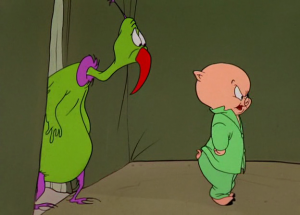 Things finally settle down – but a silver saucer appears above them, looks them over, then lands nearby. Orders flash on a screen inside the ship to capture an Earth specimen, “By order of J. Pluvius, Head Microcosm”. One of those large green bird-billed creatures that eventually became Marvin the Martian’s “instant Martians” in Hare Way To the Stars (1958) is the commander of the ship. He recurrently uses an elevator with a flexible curving shaft for ingress and egress from the ship. After a once-over of the terrain, he sets the ship to burrow under ground – and take off with a chunk of desert atop the ship – including Porky’s whole campsite. Now in space, Porky awakes complaining how cold it got all of a sudden, and gets an extra blanket. Looking out the tent flap, he sees Saturn and another planet pass at close range. “Golly, the stars are so bright tonight, you can almost touch ‘em”, quips a half-asleep Porky. The alien emerges to investigate his captures, and lays a green hand on Sylvester’s head. Sylvester freaks out, and hides in Porky’s bed (leaving large claw marks in the mattress when Porky tries to remove him). Kicked outside, Sylvester nearly falls over the edge of the small patch of land, seeing the Earth floating below. He turns white, then yellow at a second sighting of the alien.
Things finally settle down – but a silver saucer appears above them, looks them over, then lands nearby. Orders flash on a screen inside the ship to capture an Earth specimen, “By order of J. Pluvius, Head Microcosm”. One of those large green bird-billed creatures that eventually became Marvin the Martian’s “instant Martians” in Hare Way To the Stars (1958) is the commander of the ship. He recurrently uses an elevator with a flexible curving shaft for ingress and egress from the ship. After a once-over of the terrain, he sets the ship to burrow under ground – and take off with a chunk of desert atop the ship – including Porky’s whole campsite. Now in space, Porky awakes complaining how cold it got all of a sudden, and gets an extra blanket. Looking out the tent flap, he sees Saturn and another planet pass at close range. “Golly, the stars are so bright tonight, you can almost touch ‘em”, quips a half-asleep Porky. The alien emerges to investigate his captures, and lays a green hand on Sylvester’s head. Sylvester freaks out, and hides in Porky’s bed (leaving large claw marks in the mattress when Porky tries to remove him). Kicked outside, Sylvester nearly falls over the edge of the small patch of land, seeing the Earth floating below. He turns white, then yellow at a second sighting of the alien.
Porky tries to figure what’s bugging Sylvester, and finally sees the alien himself – but gets the entirely wrong idea, telling the alien to go back to his teepee and that he’ll look at his rugs and trinkets in the morning – then telling the audience, “Friendly Navajo”. The alien retreats to his ship, boning up on a book – “Denizens of the Earth and Their Behavior”. But the ship passes out of gravitational pull. The tent, Porky’s car, and a few catus plants float off the ship in one direction while the ship flies unknowingly another way. Still oblivious to the danger, Porky walks in weightlessness to get a drink of water from a canteen. Sylvester just says weightless prayers. Everything lands on another strange pink world. Porky awakes entirely rested, noting how different things look in the morning – and noting a funny-looking planet he’s never seen before in the sky (the Earth, of course). As he put-puts down the road in a model T with Sylvester, speculating they’ll reach Albuquerque by tonight, the camera pulls back – what appeared to be tree trunks on either side turn out to be the legs of giant green birds, who smile to each other with raised eyebrows at their new visitors as the scene irises out.
Woodpecker From Mars (Lantz/Universal, Woody Woodpecker, 7/2/56 – Paul J. Smith, dir.) finds Woody as the lucky kid chosen to be this week’s co-pilot on the “Captain Zoom” TV show. He wins a toy space helmet and space gun. As he leaves the studio, he crosses the street against a light. An approaching taxi veers to avoid a collision and collides with a lamppost. One of its hub caps pops out from its tire and spns through the air, catching Woody and taking him along for the ride. He flies over a group of people waiting for a bus – and intercepts all their hats in the process. Seeing him with his helmet and flying on a silver disc, the crowd cries out in unison, “A flying saucer!” Panicked news bulleting sweep every corner of the globe (including reused Walter Winchell footage from “Termites From Mars”, reviewed last week). A crowd encircles Woody on the street, with comments of “I saw him flash right out of the sky.” “I knew this would happen.” “Don’t get too close, folks…He may be radioactive.” Woody starts to play along, and fakes a few shots with his space gun, sending the crowd scattering. But suddenly, he is surrounded by the barrels of four tanks, which each make contact with his helmet from all sides and pick him up bodily. He is thrown into a net by some M.P.’s and taken to a military base for observation. A goofy professor tries a series of tests upon him.
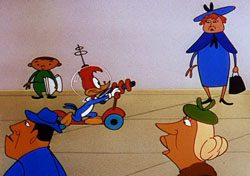 An I.Q. test is surpassed by Woody, who manages to drop a square peg into a round hole with the greatest of ease. When the professor plucks one of Woody’s tail feathers to examine it under a microscope, Woody hooks a garden hose to the microscope lens and drenches the professor through the eyepiece. A test of Woody’s endurance to ”electric neutrons” is short-circuited when Woody attaches the electrodes to the professor instead. Finally, Woody lowers an atom smasher upon the professor, lifting a standard gag from the old 1930’s Bosko cartoons, as the professor is split up into nearly a dozen little duplicates of himself. “The spaceman is crazy! Send him back to Mars!”, shouts the professor (after regrouping into his original singular form).
An I.Q. test is surpassed by Woody, who manages to drop a square peg into a round hole with the greatest of ease. When the professor plucks one of Woody’s tail feathers to examine it under a microscope, Woody hooks a garden hose to the microscope lens and drenches the professor through the eyepiece. A test of Woody’s endurance to ”electric neutrons” is short-circuited when Woody attaches the electrodes to the professor instead. Finally, Woody lowers an atom smasher upon the professor, lifting a standard gag from the old 1930’s Bosko cartoons, as the professor is split up into nearly a dozen little duplicates of himself. “The spaceman is crazy! Send him back to Mars!”, shouts the professor (after regrouping into his original singular form).
Woody is thrown into a space rocket on which is painted the words, “To Mars”. The rocket lifts off, as Woody sees the Earth disappear. A bumpy landing is made on Mars. But what reception does he get? Exactly the same treatment as he got on Earth, complete with the same comments from the crowd at the strange “Earth Man”, and the same capture and carry in a net by Martian M.P.’s. “Well, here we go again!”, says Woody for the fade out, presumably on the road to a quick return to Earth.
Rocket-Bye Baby (Warner, 8/4/56 – Chuck Jones, dir.) has been previously reviewed in my post, Holy Matrimony! And a Stack of Storks (Part 2) on this website. The tale of a Martian baby interchanged with an Earth baby on delivery presents an unexpected “invasion” of sorts, followed by communiques and a fly-by of an alien mother ship to retrieve the youngster and make the swap of the toddlers in an unexpected way with the befuddled Earth papa.
Two of Mighty Mouse’s last theatrical appearances (from the post-Gene Deitch “New Terrytoons” era, in which Mighty gave up his operatic arias for a time) dealt with space invaders. Outer Space Visitor (November, 1959 – Dave Tendlar, dir.) finds a Mouseville community dance interrupted by radio bulletin of a strange craft landing. The saucer is small, and its hatch opens in half like a baby carriage. An egg-shaped space creature, wearing a diaper, appears from within, talking up a storm in speeded gibberish and bouncing and rolling like a happy-go-lucky carefree child. While one mouse lights a cannon in reflexive sel-defense, the others make him stop, realizing the alien is only a baby. They take the creature to a professor mouse with an aptitude for languages. He has the alien speak into the microphone of a “fish and monster gurgle interpreting machine”. The seemingly harmless babblings of the baby, interpreted through the machine’s loudspeaker, suddenly turn sinister. “Just wait till my father gets here! My father is 20 feet high and 10 feet wide, and when he’s mad he tears up houses and trees and breathes fire. Here comes papa now!” True to his description, a metal monster emerges from a large spherical ship, his feet connected at the heel so they can spin as a propeller for flight. He burns up trees and devours buildings. A telegraph message is relayed by radio to the moon, sending a call for Mighty Mouse. The cheaper and overly simplified graphics of the battle are largely disappointing when compared against anything Terry had offered us in Mighty’s golden era, but Mighty socks the robot around the world several times, then peppers his rear end with a series of telephone poles which he shoots like slingshots. The aliens retreat home, and Mighty joins the dancing festivities by serving as conductor.
The Mysterious Package (Terrytoons/Fox, Mighty Mouse, 12/15/60, Mannie Davis, dir.), is considerably more satisfying, providing more screen time for Mighty and more action. This time, the “invasion” occurs by long-distance relay, as beams of energy reach the earth from an unknown planet. Fingers of light materialize mystery packages on children’s doorsteps – plus ring the doorbells. As each child opens the package, they discover a toy space helmet. But not ordinary toys. Once put on, the wearer cannot remove it – and is drawn magnetically into space to an old castle on the mystery planet. A police call goes out to Mighty Mouse (who this time is in no ethereal location, but merely in an apartment taking a bath). Donning his hero outfit, Mighty flies to police headquarters, and gets the break he needs when one package is discovered unopened on a porch. Discovering the helmet, Mighty plays guinea pig and puts it on himself – and is drawn to the scene of the crime. In the castle, he discovers a blue metal egg-shaped monster (sort of an adult version of the baby alien from the preceding episode).
The robot is equipped with ray beam from his single cyclops eye, a semi-detachable head which can be used for head butting, and an internal cannon. He also has a built-in bugle used to summon space dragons (who prove of little use as they fly at Mighty from both sides, collide, and burn each other up). The robot puts up quite a fight (even putting Mighty into a death trap of a room with converging walls), and takes some blows in return (revisiting the Bosko-style gag from “Woodpecker From Mars” of being separated into ten little versions of himself, which Mighty strikes with a marble ball from a staircase railing like bowling pins). Finally one powerful blow from Mighty has an unexpected effect – the robot shrinks, disappears – and in his place, an old man. Mighty catches him, and receives an explanation. The man claims an old witch cast a spell on him a century ago, turning him into the metal monster. He lured Mighty to his planet to break the spell. (It seems like he could have fought a little less fiercely if his intention all along was to lose!) As for the children, they have been well cared for, and are actually enjoying the time of their lives in an indoor amusement park the old man has constructed in a castle hall. Such a good time, in fact, that Mighty can’t talk the kids into going home. So he carries the whole castle, kids and all, back to Earth for a happy ending.
Lighter Than Hare (Warner, Bugs Bunny, 12/17/60 – Friz Freleng, writer and dir.), presents one of the greatest stretches of credibility to appear in a Bugs Bunny cartoon. Yosemite Sam as a spaceman? To make matters worse, Freleng couldn’t even follow the lead of his studio rival Chuck Jones and give him some new catchy name for the role like “Duck Dodgers” – instead he’s just known as “Yosemite Sam of Outer Space”. Why would a spaceman assume the name of an American national park?? Anyway, Yosemite commands a squadron of robots from a flying saucer, on a mission that seems to change objectives at will. For most of the cartoon, he is trying to capture an Earth specimen (spotting Bugs living in an old junkyard – which conveniently provides him with some old mechanical technology). But after his first failure (sending a robot who Bugs mistakes for a trash can and clogs with a load of garbage), Yosemite briefly ignores plans entirely, and sends out a robot demolition squad to destroy the Earthling altogether. They throw three loads of explosives into a “shelter” pipe Bugs has for just such emergencies. But Bugs exits the shelter out a back door, and throws a magnet into the pipe opening, drawing the demolition robots into the hole to meet the explosives head on. (A Red Cross clean-up robot, closely resembling Chuck Jones’ cleaning robot from Dog-Gone Modern (1939), sweeps up the squad’s debris.) Yosemite takes matters into his own hands, exiting the mother ship in an “indestructible tank” – a sort of a wheeled metal cold cream jar.
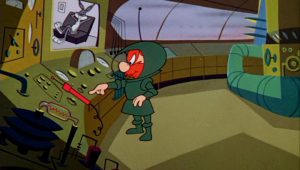 Bugs maneuvers a weird construction vehicle with robotic hands over the top of the small tank, unscrewing the lid of the tank with one robot hand, dropping a stick of dynamite down its hatch with the other hand, then hammering rivets into the replaced steel lid. Reworking Freleng’s old “nailed in a barrel” gag from Sylvester, hammering from inside the tank attempts to knock the rivets out – but the explosion occurs before the last rivet is loosened. Now Bugs tries to escape on a railroad hand car. Yosemite rockets down from the saucer onto the handcar using a jet backpack. “You Earth creatures can’t maneuver very well, can ya’” , taunts Yosemite. “Not all of us”, replies Bugs, as he merely spins his ears and takes off like a helicopter. During Yosemite’s pursuit, Bugs pulls a switcheroo, substituting two sticks of dynamite for Yosemite’s backpack – with the expected results. Bugs ultimately constructs from spare “war surplus stuff” a robot rabbit, who surrenders to Yosemite and is taken aboard ship – but is equipped with a time bomb inside. The ship flies off toward its galactic home. Back in his hole, Bugs tunes a custom short wave radio, and miraculously picks up the sounds from Yosemite’s home planet, as he presents the Earth creature to his mighty potentate. Said leader asks the rabbit “What have you got to say for yourself?” All we hear is the timed explosion. The potentate replies, “Those Earth creatures, always shooting off their mouths!” Bugs giggles, then tunes his radio set to another channel, closing with, “I wonder if ‘Amos ‘n’ Andy’ is on yet?” (A curious closing line, in that Freeman Gosden and Charles Correll had just ended their radio careers with the demise of the “Amos ‘n’ Andy Music Hall” disc jockey show shortly before this cartoon premiered – indicating the usual considerable delay and backlog at Warners’ between production dates and premiere dates.)
Bugs maneuvers a weird construction vehicle with robotic hands over the top of the small tank, unscrewing the lid of the tank with one robot hand, dropping a stick of dynamite down its hatch with the other hand, then hammering rivets into the replaced steel lid. Reworking Freleng’s old “nailed in a barrel” gag from Sylvester, hammering from inside the tank attempts to knock the rivets out – but the explosion occurs before the last rivet is loosened. Now Bugs tries to escape on a railroad hand car. Yosemite rockets down from the saucer onto the handcar using a jet backpack. “You Earth creatures can’t maneuver very well, can ya’” , taunts Yosemite. “Not all of us”, replies Bugs, as he merely spins his ears and takes off like a helicopter. During Yosemite’s pursuit, Bugs pulls a switcheroo, substituting two sticks of dynamite for Yosemite’s backpack – with the expected results. Bugs ultimately constructs from spare “war surplus stuff” a robot rabbit, who surrenders to Yosemite and is taken aboard ship – but is equipped with a time bomb inside. The ship flies off toward its galactic home. Back in his hole, Bugs tunes a custom short wave radio, and miraculously picks up the sounds from Yosemite’s home planet, as he presents the Earth creature to his mighty potentate. Said leader asks the rabbit “What have you got to say for yourself?” All we hear is the timed explosion. The potentate replies, “Those Earth creatures, always shooting off their mouths!” Bugs giggles, then tunes his radio set to another channel, closing with, “I wonder if ‘Amos ‘n’ Andy’ is on yet?” (A curious closing line, in that Freeman Gosden and Charles Correll had just ended their radio careers with the demise of the “Amos ‘n’ Andy Music Hall” disc jockey show shortly before this cartoon premiered – indicating the usual considerable delay and backlog at Warners’ between production dates and premiere dates.)
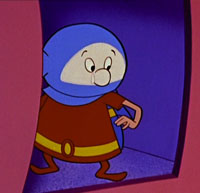
“Out Of This Whirl” (1959)
The Planet Mouseola (Paramount/Famous – November, 1960 – Seymour Kneitel, dir.), was another late effort – this time using absolute knock-offs of Herman and Katnip with only half the original duo’s personality – and less than half the animation cels. The mouse uses a plate spun by a record turntable as a flying saucer, with a wine glass on his head for a helmet. He offers the cat a job to become leader of his planet – inhabited by millions of mice. The cat instantly packs his cookbook and utensils, asking when do they blast off. But the mouse insists the cat go through a series of tests to prepare him for space travel. The tests play exactly like a series of Buzzy’s old gags to cure Katnip from some ailment (a deep-freeze chamber, for example, turns the cat into a progression of ice cubes, etc.) Eventually, the cat is launched inside a trash can marked “Catlas #1″ (reference to Atlas rockets) with a skyrocket attached, and settles into a steady orbit around the planet. One spends the whole cartoon wondering how much better it might have looked if produced only a few short years before.
Galaxia (Paramount/Famous – November, 1960 – Seymour Kneitel, dir.), the third of a series of matchmaker cartoons (though changing the matchmaker’s nationality from French to Russian in this one), deals with a new prospective groom – from outer space. An old female client (who’s waited 15 years for a groom) insists on a husband or her $300 fee back. En route to borrow the money, the matchmaker spies a landing space alien – who immediately begins romancing to – a gumball machine. Convinced that the machine is a gorgeous girl with “so many beautiful eyes”, the alien is a sucker for a sales pitch from the matchmaker, who receives $300 in gold for fixing the alien up with the gorgeous machine. A day later, however, the alien returns, unsatisfied. “She’s an old woman – falling apart”, he complains. “Whenever I hold her hand” (the machine’s handle), “her eyes fall out” (the gumballs). A new bride is in order – a juke box, who keeps singing “I love you”. Another flight back to planet Galaxia – and another return the next day. The record is stuck. “She won’t shut up. Yaketa yaketa, day and night.” All finally ends happy, as the matchmaker’s angry female client returns – and with the help of a glass vase on her head, passes as an alien for another flight to home planet – leaving everyone happy.
Unknown commodities, also from Paramount but seemingly missing in action, are “From Orbit to Obit” and “Space Squid” from the late 1960’s. No prints or data on these films has as yet surfaced. As usual, any information on these productions would again be appreciated.
 Meanwhile, back at the shield, it took three directors to piece together the strangely experimental Martian Through Georgia (Warner, 12/29/62 – Chuck Jones, Abe Levitow, Maurice Noble, dir.). With some creatively bizarre, definitely UPA inspired backgrounds, the story hinges upon a green alien from an unknown planet, mute but with a thought-projection device on the top of his head (which sometimes gives a digital display of the words he is thinking of). While everyone on his planet is happy, he is bored. He tires of levitating at will through objects. His thought projections look like illustrations from am 1890’s Sears-Roebuck catalog.
Meanwhile, back at the shield, it took three directors to piece together the strangely experimental Martian Through Georgia (Warner, 12/29/62 – Chuck Jones, Abe Levitow, Maurice Noble, dir.). With some creatively bizarre, definitely UPA inspired backgrounds, the story hinges upon a green alien from an unknown planet, mute but with a thought-projection device on the top of his head (which sometimes gives a digital display of the words he is thinking of). While everyone on his planet is happy, he is bored. He tires of levitating at will through objects. His thought projections look like illustrations from am 1890’s Sears-Roebuck catalog.
And he turns down a curvaceous female who heavily flirts with him. He sees a psychiatrist (who reads his thoughts by running an electric plug between their thought-projection apparatus), who advises him that travel will do him a world of good. Taking off by means of a giant slingshot, the alien heads for a second rate smoggy planet called Earth. On a televiewer, he observes the local flora (TV antennae), and tempo of life (rock and roll dancing). He decides his purpose in life might be to teach these backwards folk the benefits of his alien culture. But, of course, he is thrown in the slammer by the local authorities. Rearranging his molecular structure to accommodate the walls, he morphs through them and escapes. Warnings spread through the news about the “Monster”. The alien sees the story in the paper, and, not realizing that he is the subject of the story, decides to track and subdue the monster as a hero. Encountering a steam shovel in a construction yard, he zaps it with a ray gun – turning it to what appears to be a dragon, but which only harmlessly licks the face of its former operator. The alien sets out to do more good deeds – but has his ego entirely deflated by a young boy who says. “Hello, monster.” “Me?”, mimes the alien. The boy proves his point with a comic book illustration, depicting the defining point of a monster – no nose. The alien unscrews the thought projection device from his head and tries to screw it onto his face as a fake nose, but the kid is not fooled. In a censored scene, the alien considers suicide – but finally remembers that someone still loves him – the girl he left behind. In a weak ending to the film, he flies back into space, as a heart-shaped constellation forms where the narrator assures us everyone will be happy.
Mouse Trek (12/26/67 – Ralph Bakshi, dir.), the very last theatrical cartoon released by the Paramount cartoon studio, predicts the plots of such live-action adventures as “The Last Starfighter”, with an Earth cat with a reputation as a champion mouser being “recruited” by some alien cats to be their champion.
 The Earth cat (who is an absolute look-alike to Lattimore and Fenimore from the Terrytoons “Sadcat” series) is used to military overkill in his mousing tactics – employing tanks, submarines, and surface-to-air missiles just to get the drop on one little mouse. Observing his exploits from afar, the aliens cats abduct him and appoint him general in charge of all their army to battle their own mouse problem. “Oh boy”, replies the Earth cat – “Where’s my army?” The aliens inform him, “At present, you are your army.” As consolation for this disappointment, they present him with a medal – then run in panic to hide in a cave as a report of an approaching mouse is heard. The “general” is puzzled at this tactical retreat: “If I hadn’t seen it with my own eyes……” So, he saunters in the direction the mouse was coming from, determined to give the locals a good show. He is unaware as he walks that he has traveled off a cliffside, and walked onto something else – the snout of a forty-foot tall white mouse, whom he meets eye to eye. A delightful delayed realization occurs – highly akin to Sylvester’s delayed realizations when battling Hippity Hopper as the “giant mouse” – and the cat tries to regain the safety of the cliff by using one of the mouse’s whiskers as a lasso to tightrope walk to safety.
The Earth cat (who is an absolute look-alike to Lattimore and Fenimore from the Terrytoons “Sadcat” series) is used to military overkill in his mousing tactics – employing tanks, submarines, and surface-to-air missiles just to get the drop on one little mouse. Observing his exploits from afar, the aliens cats abduct him and appoint him general in charge of all their army to battle their own mouse problem. “Oh boy”, replies the Earth cat – “Where’s my army?” The aliens inform him, “At present, you are your army.” As consolation for this disappointment, they present him with a medal – then run in panic to hide in a cave as a report of an approaching mouse is heard. The “general” is puzzled at this tactical retreat: “If I hadn’t seen it with my own eyes……” So, he saunters in the direction the mouse was coming from, determined to give the locals a good show. He is unaware as he walks that he has traveled off a cliffside, and walked onto something else – the snout of a forty-foot tall white mouse, whom he meets eye to eye. A delightful delayed realization occurs – highly akin to Sylvester’s delayed realizations when battling Hippity Hopper as the “giant mouse” – and the cat tries to regain the safety of the cliff by using one of the mouse’s whiskers as a lasso to tightrope walk to safety.
The mouse yanks his whisker loose, leaving the cat dangling from it, too close to the mouse’s pointed teeth. The cat’s sheer fright jet-propels him back to the cliff, where he pounds on the door of the cave begging to be let in. The mice inside deny him shelter, but pass him another medal! The Earth cat runs further along the cliff face, and discovers in another hidden recess of the rock a secret arsenal of bombs, fuses, black powder, and weaponry. “Things are looking up!”, responds the cat. Resorting to his Earth tactics, he fires a cannon at the mouse. The mouse merely bats the cannonball back with one ear, landing the ball right in the cannon’s mouth to destroy it. The cat tries to drop an aerial bomb on the mouse from a high mountain peak – but slips off its snowy summit himself to land in a tie with the bomb, which misses the mouse completely, but not the cat. While his exploits repeatedly fail, the locals continue to decorate his chest with more medals. Finally, as the mouse sleeps at night, the Earth cat spends the entire night digging a tunnel to the mouse, and surrounding him with kegs of black powder. Retreating back through the tunnel, the cat lights a fuse, then runs for cover. The fuse burns partway – then stops. The cat lights another match, runs into the tunnel, and starts the fuse again. But the fuse fizzles out a second time. A third match, and an even longer run to attempt to start it again.
However, on the other end of the tunnel, the mouse shifts in his sleep – bumping and rolling into the tunnel about half the kegs of powder. The camera tracks above-ground the unseen action underground, as lighted match meets oncoming powder kegs. KA-BLOOEY! As the dust clears, the local population cheers their general, who has blasted about an eighth of the planet away as a large crater – but left no visible sign of the mouse. The frazzled but surprised general accepts the reception of his public – until a large white finger reaches down and taps him on the shoulder. He looks up in shock, as all the medals fall off his chest. Only a short distance above him is the mouse – standing on the other eighth of the planet which has been transformed into an orbiting asteroid. The mouse crouches, ready to spring upon the general and his helpless subjects, but the camera mercifully fades away to the Paramount logo for the final fade-out of the studio’s career. If the studio had to go, at least Bakshi managed to give it a fun and lively send-off.
Another Froggy Evening (Warner, 10/6/95 – Chuck Jones, dir.), is something of a prequel to the original One Froggy Evening (1955), demonstrating that singing Michigan J. Frog has the unusual ability to outlive many an owner through the pages of history – from prehistoric times up to the present day. Stonehenge, for example, was built as his first concert venue – but, as in the original, he never sings in public, repeatedly getting his money-craving owners in trouble. A surprise ending drops this cartoon into our subject category, as the frog’s last owner, a Robinson Crusoe type, is the only one who doesn’t see the frog as a potential money-making gold mine – but as an entree for a fast lunch! The surprise is Michigan’s rescuer, as he is beamed into the sky by the tractor beam of Marvin the Martian. Marvin is enthralled with his new find, whose froggy burbles Marvin interprets as “speaking fluent Martian”. They exit off into space, singing a sprightly duet together for the fade out.
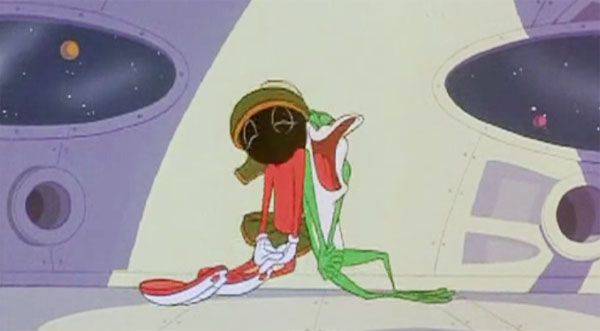
Next time, we turn our attention to television product – and the most prolific producer of sci-fi farces – Hanna Barbera.


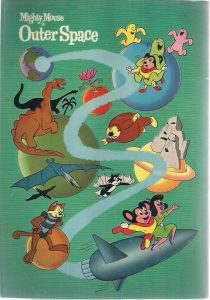
 Charles Gardner is an animation enthusiast who toils by day as a member of LA Law – but by nights and weekends indulges in classic jazz and ragtime as a performer; and studies classic Hollywood cartoons… maybe a little too much.
Charles Gardner is an animation enthusiast who toils by day as a member of LA Law – but by nights and weekends indulges in classic jazz and ragtime as a performer; and studies classic Hollywood cartoons… maybe a little too much.


































































































































































Very interesting post, with great examples and articulate, detailed descriptions. [The Bakshi “Mouse Trek” generally gets little fan love, but you highlight its virtues very well.]
But, tell me — what cartoon is that wild top-of-page image of science fiction magazines from?
That is from the Ward Kimball Disneyland episode “Mars And Beyond”.
I’m guessing Charles is going to go over that “Disneyland” episode next week among the other space themed TV cartoons.
At about the 12:55 mark https://www.youtube.com/watch?v=E0sbqqYo97s
“Boo Moon” wouldn’t be the last time Casper would be seen in space. In the early ’70’s a space capsule called “Casper” (named after astronaut, John H. Casper) was launched into space. To capitalized on this event, Harvey launch a “Casper on the Moon” campaign that included a song (which Greg talked about in a previous album) and a limited run comic series where Casper travels to the moon and back.
Out of this Whirl and Planet Mouseola (with Paramount’s psuedo-Herman and Katnip team Skit and Scat), and also The Kid from Mars, had that soon-to-be-iconic W.Sharples underscore tracked into numerous cartoons (New York-studio produced TV ones, anyhow.)
For the Warner Bros. Foghorn one, that’s Sheldon Leonard, albiet sped up, as the banty..:)
The wacky Jay Ward style spoof of Sci-Fi (before there were Jay Ward spoofs) in the Disney Science-Factitional “Mars and Beyond” is my favorite bit of animation ever. Especially that parade of silly Martian monsters chasing that poor gal.
Yosemite Sam of outer space?
Probably the best moment in that short, when Bugs swaps the rocket pack for dynamite:
“YOOO-SEMITE SAAAM OF OUTER [BOOM!] …space?”
“Hare Way to the Stars” doesn’t count? I guess because Bugs initiated the invasion. “Run for the hills folks, or you’ll be up to your armpits in Martians!”
Earth was also invaded a few times in the DePatie-Freleng theatricals:
“Bomb Voyage” (1967). UFO sightings panic Paris, and the commissioner is ordering the inspector to quash the rumors when he is abducted by aliens himself. Their method of capture: brazenly walking right into the police station, blasting the commish with a shrink ray and carrying him off in a jar. [ https://www.youtube.com/watch?v=Rm2TWM84tBQ ]
“Mesa Trouble” (1974). The alien here wasn’t planning to invade the earth, but when his flying saucer gets shot down, Hoot Kloot convinces the spaceman to incapacitate the bandit he had been chasing throughout the cartoon thus saving Kloot the trouble of doing it himself. [ https://www.youtube.com/watch?v=zyB45CTDE6w ]
“Pink U.F.O.” (1978). Made when DFE was the last man standing in the theatrical short business. The insect-sized spacecraft (manned by the littlest of little green men) is a creative idea, but the short suffers from some very sloppy camerawork and editing. [ https://www.youtube.com/watch?v=Qkvuxi1Ns_U ]
I don’t watch many Paramount cartoons from the sixties, as I find the studio’s senescent output altogether too depressing, but I quite enjoyed the selection here. In fact “Galaxia” had me laughing out loud!
And Bill Lava’s score to “Martian Through Georgia” is surprisingly, and uncharacteristically, clever.
That shot of the audience laughing in “The Kid from Mars” — was that recycled from an older cartoon, possibly a Screen Song? The design and animation of that scene are much more sophisticated than anything else in the cartoon.
The laughing audience was reused animation, a shot by Steve Muffatti, from a Casper short, Ghost Of The Town (1952).
Regarding ‘Martian through Georgia’:
I thought the narrator’s line about Earth’s flora and fauna closed with referencing the rock n’ roll dance hall as ‘the local temples’ as opposed to tempo. Have I just been mishearing it all these years?
It certainly sounds like “temples” to me, David.
In the newsreel parody “Phony News Flashes” (Terrytoons/Fox, 1/8/55 — Connie Rasinski, dir.), the announcer tells us: “At hearings today, the committee on space investigation decided that reported visits by creatures from another planet are a complete hoax.” Addressing the committee is a green-skinned, one-eyed, pointy-eared alien with a lightning bolt on his shirt and a light bulb growing out of his head, assuring them that “these reports are a complete hoax.” He then dons a propeller beanie, spins its blade, then takes off and flies out the window.
In the forties, the propeller beanie was a symbol of science fiction fandom. I’m just glad it had gone out of fashion by the time I discovered the genre in my teens.
In “Pride of the Yard” (Terrytoons/Fox, 26/7/54 — Eddie Donnelly, dir.), tea-sipping Hemlock Holmes look-alike Percival Sleuthhound is determined to capture a couple of escaped convicts and bring them in to Scotland Yard; and no matter how they try to put him out of the way, he keeps coming back (rather like Droopy, whom he also resembles). At one point the crooks blindfold him and put him on a rocket to Mars, thinking they’re finally safe when it launches into the sky. But a moment later, a flying saucer lands, and a lavender-skinned Martian with an antenna growing out of his head deposits Percival back on English soil. “Rather a roundabout way to the Yard, what?”